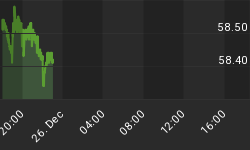I. Details From The Charts Reveal The Safety Of Cash
The S&P 500 Large Cap Index Chart ($SPX, ^SPX) shows recovery from the its early May fall to its 9-15- 2006 shooting star finale and peak.

The Chart of ICF relative to SPY shows that the commercial real estate sector has given investors even better rewards that the S&P.

The daily chart of the CRB Index shows a Fractal Breakdown on 9-8-2006

The monthly chart of the CRB Index shows this Fractal Break dramatically: this is called the September 2006 'commodities bust'.

The Chart of $SPX relative to $CRB shows that the value of financial stocks relative to commodities is greatly overvalued; the S&P will soon go lower to correct this imbalance.

The Chart of CRX.X , Morgan Stanley Commodities Related Index, shows the stock value of commodity producers, such as Alcan (AL), peaked in early 2006 and entered into an Elliott Wave 3 Down in late March 2006. Notice the mini-peak and sell of in September which reflects the Commodities Bust of 9-8-2006.

The One Year Chart of Alcan shows it falling below critical support level of 40 to close at 39.46; note the head and shoulders formation in this chart which is an ominous warning to investors in this stock.

The Weekly Chart of Newmont Mining as of 9-20-2006 shows a Fractal Break outside the support of a symmetrical triangle in a dramatic Elliott Wave 3 Down. Note how Elliott Wave 1 Down and 2 Up were within the support triangle. Newmont's drop suggests that financial stocks can manifest similar sharp declines.

The Monthly Chart of Newmont Mining as of 9-15-2006 shows Newmont falling below support and augers the end to a bull market both in Newmont and stocks in general.

The 9-15-2006 Weekly Chart of the HUI Index and also The 9-15-2006 Weekly Chart of the XAU Index show the 9-8-2006 Fractal Break Down in gold stock prices and these charts reflect the end of an age where stocks serve as a means of wealth accumulation and preservation.


The Chart of the ETF (OIH) as of 9-20-2006 with price of 122.51 shows the start on an Elliott Wave 3 Down
in oil field service providers. Note the 9-8-2006 Fractal Break Down in price.

The Chart of Russell 2000 ($RUT) on 9-21-2006 shows both a bearish engulfing pattern and a Fractal Break
Down.

The Chart of Dow Jones Industrials ($INDU) shows a Fractal Break Down on 9-21-2006.

The Chart Of The ETF (DIA) Relative To Gold shows that the recent up-burst in Dow Industrials relative to Gold is only a brief temporary upswing: this chart definitely shows that the value of Dow Stocks relative to Gold peaked in April-June 2005.

II. 'Gold Bugs' Encourage Investing 'Soon' In Gold
'Gold Bugs', the perennial stock market bears who perceive genuine wealth to be in tangible assets rather than intangible assets, present reasons for investing in gold:
Paul van Eeden in Wait For Gold To Decouple From Base Metals presents the concept that gold will decouple from the falling price of commodities and have an upwardly mobile price.
Alf Field in Elliott Wave Gold Update VIII presents an Elliot Wave Bottom for gold between $570 and $540. If this is the case, gold may have already bottomed on 9-15-2006 with an intra day price of approximately $575.
Ron Griess in Chart Analysis of Gold presents a chart of gold in an upwardly mobile pattern with its 300 day moving average continually serving as a base. In as much as gold is currently trading at about $580 and the moving average is $545, purchasing gold at it's current price can be justified.
Doug Noland in Monetary Disorder Watch presents the risk of plummeting stock prices stating: "If the Bernanke Fed is relieved by - or perhaps even celebratory of - the decline in energy and commodity prices in conjunction with gains in stock and bond prices, I suggest to them that they should instead be extremely concerned with the unprecedented degree of speculation in U.S. and global securities markets...Rampant and unmanageable Credit Inflation and its myriad effects remain their chief worry. As such, a speculative run in U.S. equities would essentially culminate Monetary Disorder's worst-case scenario."
Jan Allen in It's Time To Develop A North American Union Financial Survival Plan presents the risk of political tensions and a falling U.S. dollar, writing that the Cancun Summit mandated the North American Union by 2007; and that the declarations of this Summit place one's financial wealth at risk like no other event or development in economic history. Therefore, one needs to give careful and considered thought to replacing one's fiat financial portfolio with a gold based -- a commodity based one.
III. Places For Investing In Gold Include the ETF (GLD) and BullionVault.com
If one has less than $2,000, one can invest in the ETF (GLD) but this carries risk as it is not a real asset.
If one has more than $2,000, one can buy, store and sell gold at Bullionvault.com. The advantage of this service is that one personally owns the commodity where it is guarded by Brinks - a global leader in security.















